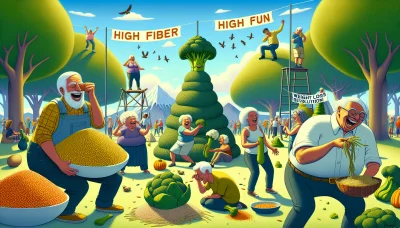Foods high in fiber for toddlers Quiz
Test Your Knowledge
Question of
Understanding Fiber and Toddlers' Health
Importance of Fiber in a Toddler's Diet
Fiber is a superhero in the world of toddler nutrition! It keeps their digestive systems running smoothly and helps prevent constipation, which can be a real party pooper for little ones. Plus, it's a fantastic appetite regulator, making sure your tot doesn't overeat.
But wait, there's more! Fiber isn't just about digestion; it also plays a critical role in reducing the risk of chronic diseases later in life. Imagine fiber as a tiny investment into your child's long-term health bank account!
Nutritional Benefits of Fiber
Fiber is like the unsung hero that works behind the scenes. It supports heart health by keeping cholesterol levels in check. It also partners with good bacteria in the gut to build a stronger immune system, helping toddlers fight off germs with superhero strength!
And let's not forget blood sugar levels fiber helps keep them stable, preventing those sugar highs and lows that turn toddlers into tiny tornadoes. Its essential for maintaining energy levels so they can play, learn, and grow without unnecessary interruptions.
Recommended Daily Fiber Intake for Toddlers
How much fiber does your little dynamo need? Well, for toddlers aged 1-3 years old, aim for about 19 grams of fiber daily. Think of it as their daily dose of awesome to keep them bouncing along happily!
Dont stress about hitting that number with precision its not a high-stakes game show. Just focus on including fiber-rich foods like fruits, veggies, and whole grains into their meals and youll be on track.
Identifying Signs of Fiber Deficiency
Common Symptoms in Toddlers
If your tot is turning down trips to the bathroom or complaining about belly pains, take note these could be distress signals from a lack of fiber. Keep an eye out for other red flags like irregular bowel movements or hard stools.
Besides tummy troubles, if your kiddo seems less energetic than usual or has trouble concentrating during playtime puzzles, it might be time to peek at their fiber intake.
When to Consult a Pediatrician
- Persistent Digestive Issues: If bathroom battles become a regular drama.
- Sudden Changes in Appetite: When favorite foods are suddenly foes.
- Growth Concerns: If growth spurts seem more like growth pauses.
- Bowel Movement Changes: When potty patterns go haywire without explanation.
- Frequent Illnesses: If your little one is catching colds quicker than catching balls.
Balancing Fiber with Other Nutrients
Creating a Well-Rounded Diet
A balanced diet for toddlers is like building with blocks you need different shapes and sizes for the perfect structure. Make sure fiber-rich foods are part of this mix but don't forget proteins, fats, and carbs too!
Incorporate colorful fruits and veggies alongside proteins like chicken nuggets (a toddler staple!) and whole grains. This way, you're painting a nutritional masterpiece that would make even Picasso proud!
Avoiding Excessive Fiber Intake
Hitting the fiber jackpot isn't always cause for celebration too much can lead to tummy upsets or nutrient absorption issues. It's all about finding that sweet spot where everything runs smoothly.
Moderation is key! Just as superheroes have their limits, so does fiber intake for toddlers. Keep portions appropriate for tiny tummies to ensure they're getting just what they need to thrive without going overboard.
Top Fiber-Rich Foods for Toddlers
Fruits to Boost Fiber Intake
Fiber is an essential part of a toddler's diet, and fruits are a delightful way to increase their intake. Not only do fruits offer vitamins and minerals, but they also come packed with natural fibers that aid digestion. Offering a variety of fruits can keep toddlers interested and willing to try new flavors.
It's important to introduce fiber-rich fruits in a fun and engaging manner. Presenting them in colorful assortments or as part of a game can encourage toddlers to enjoy their healthy snacks. Always ensure fruits are cut into appropriate sizes to prevent choking hazards.
Berries and Their Fiber Content
Berries are tiny powerhouses of fiber and are often well-loved by little ones. Strawberries, blueberries, raspberries, and blackberries can be easily incorporated into a toddler's diet through cereals, yogurts, or as finger foods. Their vibrant colors and sweet taste make them irresistible snacks that pack a fibrous punch.
When selecting berries for toddlers, opt for organic when possible to reduce exposure to pesticides. Fresh berries are optimal, but frozen varieties can also be nutritious alternatives when out of season. Remember, the darker the berry, the higher its antioxidant content.
Pears and Apples as Snack Options
Pears and apples stand out as excellent sources of dietary fiber for toddlers. Their soft texture makes them easy to chew, while their natural sweetness appeals to young palates. These fruits can be served raw with the skin on for maximum fiber benefit or cooked into sauces and compotes.
To maintain the interest of toddlers in these fruits, try slicing them into fun shapes or pairing them with nut butter for a tasty treat. Always supervise your toddler while they eat to ensure safety, especially when consuming fruits with skins.
Vegetables That Toddlers Love
Veggies might not always be at the top of a toddler's preferred foods list, but they're crucial for providing fiber and nutrients. Introducing vegetables in creative ways can help toddlers develop a taste for these healthful options early on.
Always aim to serve vegetables in a variety of textures and flavors. Roasting or steaming can bring out natural sugars in veggies, making them more palatable for young children. Encouraging kids to help prepare their own vegetable snacks may also increase their willingness to try new things.
Sweet Potatoes and Peas
Sweet potatoes are not just delicious; they're also brimming with fiber! Their naturally sweet flavor appeals to toddlers, making them a great side dish or main component in meals. Sweet potato fries or mashed sweet potatoes are both kid-friendly options.
Peas are another fantastic source of fiber for toddlers. They can be served alone or mixed into dishes like rice or pasta. Their small size makes them perfect for practicing fine motor skills as children learn to pick them up one by one.
Broccoli and Carrots: Making Them Fun to Eat
- Introduce broccoli and carrots through dipping: Pair these veggies with healthy dips like hummus or yogurt-based sauces.
- Create playful shapes: Use cookie cutters to turn broccoli florets and carrot slices into fun designs that spark interest.
- Mix them into favorites: Incorporate finely chopped broccoli and carrots into familiar dishes like spaghetti sauce or macaroni cheese.
- Lead by example: Eat these vegetables enthusiastically in front of your toddler they're more likely to mimic your healthy eating habits!
Whole Grains for Everyday Meals
Incorporating whole grains into everyday meals provides an easy avenue for boosting fiber intake in toddlers' diets. Whole grains contain more nutrients than their refined counterparts due to the preservation of the bran and germ layers. They should be introduced gradually while monitoring how well they're tolerated by your child's digestive system.
Serving whole grains doesn't have to be boring! Toddlers will enjoy trying different types of breads, pastas, and cereals if they're presented in an appealing manner. Making sure these options are available at mealtime can familiarize toddlers with healthier grain choices from an early age.
Oatmeal Variations for Breakfast
Oatmeal is a versatile breakfast option that can be jazzed up with various toppings like fruit purees, cinnamon, or even a dollop of peanut butter. It's naturally high in fiber which helps maintain regular bowel movements in toddlers. Instant oatmeal varieties often contain added sugars; opting for old-fashioned oats is healthier as it allows you control over the sweeteners used.
Quinoa and Brown Rice Dishes
Quinoa is an excellent source of protein along with its high fiber content making it ideal for growing toddlers. This grain-like seed can be served as it is or incorporated into patties and salads that appeal to young ones' tastes. Brown rice is another wholesome option that pairs well with nearly any dish while providing beneficial fiber needed for digestive health.
Incorporating Fiber into Toddlers' Diets
Introducing fiber into a toddler's diet is crucial for their digestive health and overall well-being. Fiber aids in digestion, helps prevent constipation, and can even contribute to long-term health benefits like reducing the risk of heart disease. It's important to ensure toddlers get an appropriate amount of fiber through a balanced diet.
When it comes to toddlers, gradual changes are key. Adding too much fiber too quickly can lead to discomfort and gas. Start with small portions of fiber-rich foods and increase slowly. Always pair fiber with plenty of fluids to help the body process it efficiently.
Easy Fiber-Rich Recipes for Busy Parents
Busy parents need quick, fiber-rich recipes that toddlers will love. Whole grains, fruits, vegetables, beans, and legumes are excellent sources of fiber. Incorporating these into meals can be simple with a bit of creativity. For example, blending veggies into pasta sauces or adding fruit to breakfast cereals can significantly boost fiber content.
Cooking with whole grain flours, such as using whole wheat flour in pancakes or muffins, is another effective way to increase your toddler's fiber intake. These minor tweaks in your usual recipes can make a big difference in meeting your child's dietary needs without taking up extra time.
Quick Snack Ideas
Snacks are a great opportunity to sneak extra fiber into a toddler's diet. Offer snacks like apple slices with peanut butter or whole-grain crackers with cheese. These options are not only packed with fiber but also provide additional nutrients like protein and healthy fats that are essential for growth.
Simple and Nutritious Meal Preparations
Preparing nutritious meals doesn't have to be complicated. Simple dishes like brown rice stir-fry with vegetables or oatmeal topped with berries offer substantial amounts of fiber. Such meals are easy to prepare and can be customized according to what your toddler prefers.
Tips for Introducing New Foods to Picky Eaters
Picky eaters often reject new foods on the first try; persistence is crucial. Presenting the new food alongside familiar favorites can encourage them to explore different tastes and textures without feeling overwhelmed by a plate full of unknowns.
- Mix New Foods with Favorites: Combine new items with foods your child already enjoys. This can make the unfamiliar more approachable.
- Involve Your Child: Letting toddlers help in meal preparation may pique their interest in eating what they've made.
- Presentation Matters: Create fun shapes or faces with food to entice your child's curiosity and appetite.
- Avoid Pressure: Keep mealtimes positive without forcing them to eat certain foods as this can create negative associations.
- Be Patient: It may take several exposures before a child accepts a new food. Dont give up too soon!
Gradual Introduction Strategies
To smoothly introduce new high-fiber foods, start by mixing them into dishes your toddler already enjoys. For example, add pureed vegetables into spaghetti sauce or mashed beans into ground meat dishes. Gradually increase the proportion as your toddler becomes accustomed to the taste.
Making Food Fun and Appealing
Creativity goes a long way when introducing new foods to picky eaters. Use cookie cutters for fun food shapes, make colorful fruit and veggie plates, or tell stories about where the food comes from. Engage their senses and imagination!
Ensuring Adequate Hydration with Increased Fiber
Increase in dietary fiber calls for increased hydration as well. Water helps move fiber through the digestive system and prevents potential issues like constipation. Monitor your toddler's fluid intake closely as you up their fiber consumption.
Importance of Water Intake
The importance of water intake cannot be overstated for toddlers on high-fiber diets. It facilitates digestion and helps maintain regular bowel movements. Offer water regularly throughout the day, especially after meals and snacks.
Healthy Drinks for Toddlers
Apart from water, other healthy drinks that support hydration include milk (which provides calcium) and small amounts of 100% fruit juices without added sugars. However, water should always be the primary source of hydration associated with increased dietary fiber.
Managing a High-Fiber Diet for Toddlers
Monitoring Toddler's Digestive Health
Keeping tabs on your toddler's digestive health is paramount when managing a high-fiber diet. You should observe their bowel movements and overall comfort after eating. It's crucial to ensure they're getting enough hydration to complement the fiber intake, as this combo keeps digestion smooth.
Recognizing Normal vs. Abnormal Digestive Changes is a game-changer. Normal changes include regular, soft bowel movements, while red flags may be frequent diarrhea or unusually hard stools. If any abnormal signs arise, it's time to reevaluate the fiber content in their meals.
Adjusting Fiber Intake Accordingly should be done with precision and care. A gradual increase in fiber prevents shocking the system, while a decrease might be necessary if issues arise. Balancing the diet with a variety of foods ensures nutrient diversity and promotes better digestive health.
Dealing with Potential Fiber-Related Issues
Addressing Constipation Naturally can often be achieved with increased fluid intake and adding high-fiber foods like pears or peas into your toddlers diet. Gentle abdominal massages and encouraging movement through play are excellent non-invasive ways to get things moving.
Handling Gas and Bloating in Toddlers can sometimes be tricky but is essential for their comfort. Introducing high-fiber foods slowly and ensuring proper chewing can mitigate these issues. Probiotics found in yogurt also help maintain a healthy gut flora, further reducing gas problems.
Educating Toddlers on Healthy Eating Habits
The foundation of lifelong healthy eating starts now! Role Modeling and Positive Reinforcement are your secret weapons. When toddlers see you enjoying nutritious foods, they're more likely to follow suit. Celebrate their choices when they reach for fruits or veggies instead of sweetsit'll make a lasting impact!
Interactive Learning Activities About Nutrition can transform mealtime into fun time! Create games around choosing colorful vegetables or sorting foods by texture or size. This not only makes learning about nutrition exciting but also encourages them to try new foods.
- Start Slow: Gradually introduce high-fiber foods to prevent digestive discomfort.
- Mix It Up: Combine high-fiber foods with familiar favorites to make them more appealing.
- Stay Hydrated: Encourage drinking water throughout the day to aid digestion.
- Friendly Fibers: Opt for kid-friendly fiber sources like applesauce or oatmeal that are less intimidating.
- Sneaky Chef: Incorporate pureed vegetables into sauces or smoothies for an unnoticed fiber boost.
- Balanced Approach: Ensure meals have a good mix of protein, fats, and carbohydrates along with fiber.
- Lively Learning: Use interactive tools like coloring books or apps focused on nutrition education.
- Patient Persistence: If at first theyre reluctant, dont give uptaste preferences evolve over time!
Planning a Balanced Fiber-Rich Menu for Toddlers
Sample Daily Meal Plans with High Fiber Content
Crafting a daily meal plan rich in fiber is crucial for your toddler's growth and digestive health. Start by including whole grains, fruits, and vegetables across all meals. For instance, oatmeal topped with berries offers a fiber-packed breakfast, while whole wheat pasta with veggies can round out dinner. Balance is keyensure protein and healthy fats are also on the plate.
Consistency in offering high-fiber foods helps toddlers adjust to the flavors and textures. A colorful variety of beans, lentils, and peas can be intriguing for them and provide essential fiber. Remember to introduce new foods gradually and pair them with familiar favorites to encourage acceptance.
Breakfast Ideas to Start the Day Right
Breakfast is the perfect opportunity to introduce fiber into your toddler's diet. A smoothie made with spinach, bananas, and chia seeds can be both appealing and nutritious. Whole grain pancakes served with a dollop of yogurt and fresh fruit slices also make a delightful high-fiber start to the day.
Lunch and Dinner Combinations for Optimal Nutrition
Lunches and dinners that combine lean proteins with fiber-rich sides cater to your toddler's nutritional needs without compromising taste. Think grilled chicken with quinoa salad or fish fillets with sweet potato fries. Each meal should be a harmonious blend of taste and health benefits.
Snacks That Support a High-Fiber Diet
Snacks are an excellent way to sneak extra fiber into your toddler's diet between meals. Fresh fruit slices, vegetable sticks with hummus, or whole grain crackers can be both satisfying and beneficial for their digestive system. Be mindful of portion sizessnacks should complement meals, not replace them.
Homemade Treats with Nutritional Value
Homemade snacks give you control over ingredients and ensure that your child gets the nutrition they need without unnecessary additives. Baked pear or apple chips are a sweet treat loaded with fiber. Similarly, oatmeal cookies with added nuts or dried fruits can be both delicious and nourishing.
Store-Bought Snacks That Are Actually Healthy
When choosing store-bought snacks, always read labels carefully to avoid hidden sugars or excess sodium. Look for products that list whole grains as the first ingredient and have recognizable components. Some great choices include rice cakes, low-sugar granola bars, or popcorn (for older toddlers who can safely chew it).
Adapting Family Meals for Toddler's Needs
Adapting family meals for toddlers doesn't have to be complicated or time-consuming. By making simple substitutions like brown rice instead of white or adding shredded vegetables into meatballs, you can significantly increase the nutritional value of common dishes. These small tweaks make meals more toddler-friendly without sacrificing flavor for the rest of the family.
Making Small Changes for Big Nutritional Gains
Introducing more vegetables into dishes like casseroles or pasta sauces is an easy way to boost fiber intake discretely. You might also consider serving fruit compotes as a dessert alternative that's both sweet and fibrous. Every little modification contributes towards building healthy eating habits early on.
Involving the Whole Family in Healthy Eating
Making healthy eating a family affair can encourage your toddler to try new foods rich in fiber. When they see everyone at the table enjoying the same nutritious meals, they're more likely to join in. Plus, involving older children in meal prep can teach them about nutrition while they help create exciting dishes everyone will love.
-
*Tips for Creating Fiber-Rich Menus for Toddlers:
Overcoming Challenges with High-Fiber Diets for Toddlers
Addressing Common Concerns About Fiber Intake
Introducing a high-fiber diet to toddlers can sometimes be met with resistance, but it's crucial for their digestive health. Parents often worry about the potential for gas or bloating. However, incrementally increasing fiber while ensuring adequate hydration can mitigate these issues. It's all about balance and listening to your child's body.
Another concern is the fear of fiber overshadowing other essential nutrients. A diverse diet is key! Make sure that high-fiber foods are part of a varied menu that includes proteins, fats, and vitamins. This ensures a holistic approach to your toddler's nutrition, keeping them both full and nourished.
Allergies and Food Sensitivities to Consider
Allergies and sensitivities can complicate fiber intake in toddlers. It's vital to identify any adverse reactions to high-fiber foods and seek alternatives. Foods like berries, beans, and whole grains are great, but always be on the lookout for signs of allergies.
If you suspect food sensitivities, consult with a healthcare professional before making dietary changes. They can help pinpoint the problem foods and suggest high-fiber options that won't cause discomfort or allergic reactionsmaintaining a happy gut without the distress.
Balancing Fiber with Other Dietary Restrictions
When other dietary restrictions are in play, balancing fiber intake becomes a delicate dance. For toddlers with gluten intolerance or other conditions requiring special diets, it's crucial to find suitable fiber sources. Gluten-free whole grains like quinoa and buckwheat can be excellent alternatives.
Finding this balance often requires research and sometimes trial and error, but it doesn't have to compromise on taste or variety. There are numerous delicious recipes and products designed for restricted diets that are also rich in fiberso your little one won't miss out!
Strategies for Consistent Dietary Habits
Establishing Routines Around Meal and Snack Times
A structured eating schedule sets the stage for consistent fiber intake throughout the day. Regular meal and snack times prevent overeating and ensure that there's room for those high-fiber foods at every sitting. Consistency is king when forming healthy habits!
Routines also help parents plan ahead, making it easier to incorporate a variety of fibrous foods into their toddlers diet. By having set times for meals and snacks, you avoid the pitfalls of random snacking which can lead to poor dietary choices.
Encouraging Self-Feeding with Fiber-Rich Foods
Self-feeding is not just about independence; it's also an opportunity to introduce high-fiber foods in an engaging way. Offer your toddler finger foods like soft-cooked vegetables or small pieces of fruit that are easy to handle. This encourages exploration and enjoyment of fibrous foods.
- Make it fun: Use colorful plates or arrange food in playful shapes.
- Dip it: Provide healthy dips like hummus or yogurt to entice toddlers.
- Mix textures: Combine different textures to keep things interestingcrunchy carrot sticks with smooth avocado slices, for example.
- Educate: Talk about the benefits of these foods as they enjoy themthis builds both knowledge and positive associations.
- Praise: Celebrate when they try new fibrous foodsit reinforces good behavior!
- Variety is key: Rotate options so they don't get bored with the same items.
- Lead by example: Eat high-fiber foods yourself; toddlers love mimicking adults!
Seeking Professional Advice When Needed
When to Talk to a Nutritionist or Dietitian
If you're struggling with incorporating enough fiber into your toddler's diet or facing unique challenges such as picky eating, don't hesitate to seek expert advice. A nutritionist or dietitian specializes in crafting diets that meet all nutritional needs while accommodating personal circumstances.
Their expertise can be invaluable in navigating complex dietary requirements or simply providing peace of mind that you're on the right track. An individualized plan takes the guesswork out of meal planningensuring your toddler gets all the benefits of fiber without any negative side effects.
Collaborating with Pediatricians for Personalized Plans
Your childs pediatrician is an essential partner in monitoring their growth and developmentincluding their diet. They understand your childs health history and can provide tailored advice that aligns with their specific needs. Dont overlook this resource!
Pediatricians often have practical tips up their sleeves from years of experience working with young families. They can suggest simple adjustments, recommend supplements if necessary, or refer you to specialists who can offer further guidance on crafting a high-fiber diet that works wonders for your toddler!












